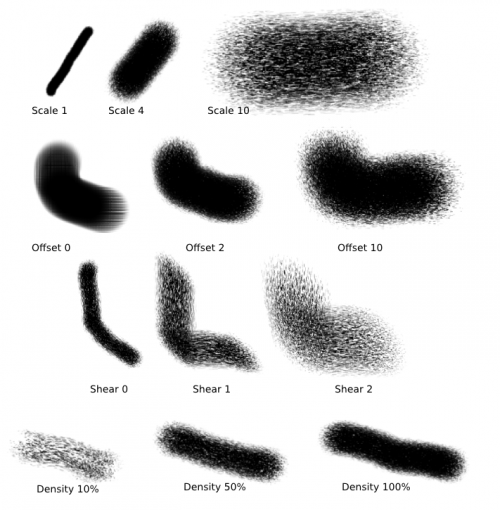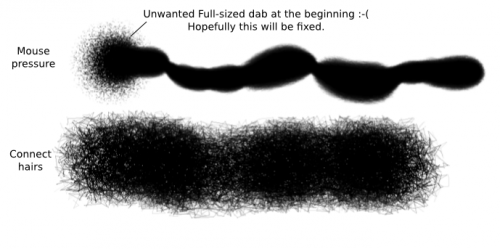Kıl Fırça İşletkesi¶
Gerçek hayattaki fırçaların çizgilerini veya kıllarını çizerek onlara öykünmeyi amaçlayan fırça.
Fırça Ucu¶
Kısaca:
Fırça ucu, kılların bulunduğu alanları belirler.
Daha düşük matlıklı alanlarda daha düşük matlıklı kıllar bulunur. Bu fırça, daha düşük matlıklı alanlarda daha az kıl varmış gibi bir izlenim yaratabilir.
Size ve Rotation devingenlikleri fırça ucunu etkiler, kılları değil.
Yapabilecekleriniz:
Farklı efektler için farklı şekiller kullanın. Karmaşık fırça şekillerinin daha yavaş çizeceğini ve efektlerin her zaman görünür olmayacağını unutmayın (çünkü sonunda belirli sayıda kıl bulunan bir alanın üzerinden geçiyorsunuz).
Kıl yoğunluğunu azaltmak için kendiliğinden oluşan fırçayı kullanıp fırça ucunun yoğunluğunu azaltabilir veya rastgeleliğini artırabilirsiniz.

Kıl Seçenekleri¶
Bu özel fırça işletkesinin çekirdeği.
- Ölçek
Bunu, kılları birbirinden daha da ayırmak için fırçaya bastırmak gibi düşünün.
Daha büyük değerler temel olarak size daha büyük fırçalar ve daha geniş kıl aralıkları sağlar. Örneğin, 4 değeri temel fırça boyutunuzu 4 ile çarpar; ancak kıllar arasındaki aralık 4 kat daha fazla olur.
“Yoğun” bir fırça istiyorsanız yani ortada çok fazla kıl görmek istemiyorsanız daha küçük değerler kullanın.
Negatif değerler, karşılık gelen pozitif değerlerle aynı etkiye sahiptir: −1,00; 1,00 gibi görünecektir, vb.
- Rastgele Ofset
İzleyen çizgilere engebeli bir görünüm kazandırır.
0,00’da tüm kıllar temelde tamamen paralel kalır.
Diğer değerlerde kıllar rastgele yer değiştirir. Büyük değerler, kılların etrafa yayılması nedeniyle fırça boyutunu biraz artıracaktır; ancak çok fazla olmayacaktır.
Negatif değerler, karşılık gelen pozitif değerlerle aynı etkiye sahiptir.
- Kaydır
Kaydırma, fırçanıza oval bir fırçayla (veya yuvarlak bir fırçanın kenarıyla) çizim yapıyormuşsunuz gibi bir açı kazandırır.
- Yoğunluk
Bu, kılların yoğunluğunu denetler. Ölçek, birkaç kılı alır ve bunları daha yoğun bir alana genişletir veya sıkıştırır; yoğunluk ise sabit bir alanı alır ve içindeki kıl sayısını belirler. Farkı görüyor musunuz?

- Fare basıncı
Bu, “Ölçek”i fare hızına eşlemler ve böylece grafik tabletiyle basıncı benzeştirir!
Bunun yerine, ölçeği belirlemek için “iki olay arasındaki uzaklığı” kullanır. Daha hızlı çizim, daha büyük uzaklıklar.
Bu, başka hiçbir şey (boyut, matlık, döndürme vb.) için “basınç” girdisini etkilemez, dolayısıyla bunları yine de bağımsız olarak başka bir şeye eşlemlemeniz gerekir.
- Eşik
Bu bir tablet özelliğidir. Bunu açtığınızda, yalnızca “tuvale dokunabilen” kıllar boyanacaktır.
- Kılları bağla
Kıllar birbirine bağlanır. Kendiniz görün.
- Yumuşatma
Bu, çizgilerin pürüzlülüğünü azaltacaktır.
- Bileşik kıllar
Bu, “kıl renklerini tek bir dokunuşta oluşturur”; ancak etkinin “büyük olasılıkla çok ince” olduğunu açıklar.

Mürekkep tükenmesi¶
Bu, çizim süresi boyunca mürekkep tükenmesinin benzeştirilmiş halidir. Değer, ne kadar süreceğini belirler. Eğri ise hızı belirler.
- Matlık
Mürekkebin bitmesini benzeştirmek için fırça saydamlaşır.
- Doygunluk
Mürekkebin bitmesini benzeştirmek için fırçanın doygunluğu azaltılır.

- Mürekkebi emdir
Fırça, diğer fırçalardan renkleri alır. Bu seçeneği etkinleştirmek için Mürekkep tükenmesi seçeneğini işaretlemeniz gerekmez, yalnızca Mürekkebi emdir seçeneğini işaretlemeniz yeterlidir. Bu, fırçanın kıllarının dokundukları ilk alanın renklerini almasını sağlar. Kıl fırça bağımsız kıllardan oluştuğu için temelde aynı anda birkaç renk alabilirsiniz.
Not
Yalnızca fırçanın ölçeklendirilmemiş alanındaki renkleri alacaktır, bu nedenle örneğin 4,00 ölçekli bir fırça kullanıyorsanız yalnızca merkeze en yakın ¼ alandaki renkleri alacaktır.
Kaynak saydam olduğunda kıllar siyah renk alır.

Uyarı
Bu özelliğin biraz hatalı olduğunu unutmayın. Rengi geçerli katmandan alması gerekiyor; ancak hatalı bir davranış nedeniyle genellikle (kıl olmayan bir fırçayla mı?) boyadığınız son katmanı kaynak olarak kullanıyor. Bu tür garip davranışlardan kaçınmak için tek bir katmana bağlı kalın veya önce başka bir fırçayla (örneğin bir piksel fırçasıyla) geçerli etkin katmana bir şey boyayın.
- Ağırlıklı doygunlaştırma
Aşağıdakilerle doygunluğu değiştirerek çalışır:
Basınç ağırlığı
Kıl uzunluğu ağırlığı
Kıl mürekkebi ağırlığı
Mürekkep tükenme eğrisi ağırlığı
